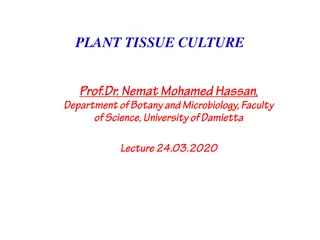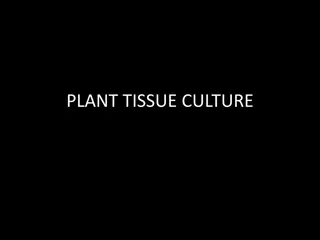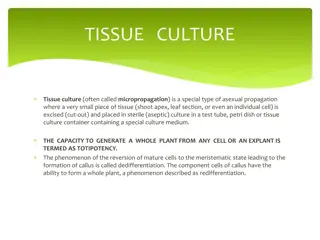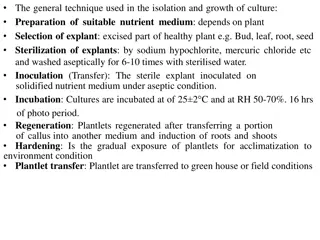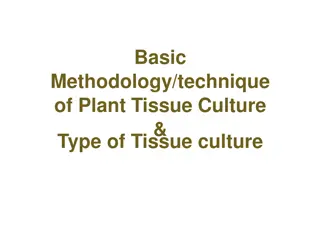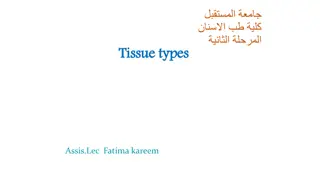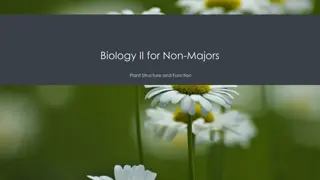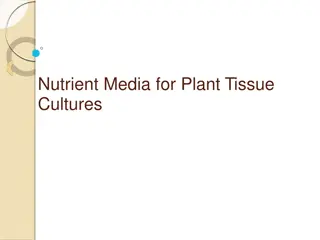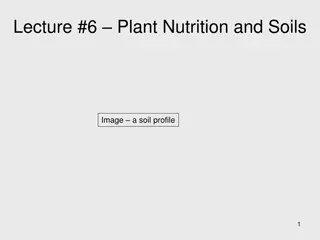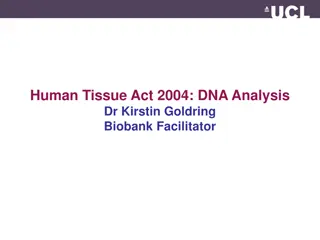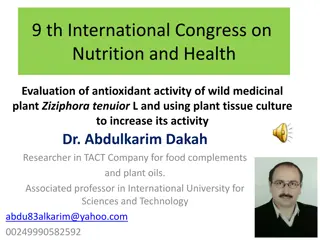Understanding Organogenesis in Plant Tissue Culture Techniques
Plant regeneration through tissue culture techniques such as organogenesis plays a vital role in micropropagation and organ production. Factors affecting organogenesis include donor plant growth, culture medium, growth regulators, and environmental conditions. Chemical regulation and the use of epidermal and subepidermal explants have shown precise control over organ formation. Recent studies also highlight the influence of cell wall oligosaccharides on organogenesis.
Download Presentation

Please find below an Image/Link to download the presentation.
The content on the website is provided AS IS for your information and personal use only. It may not be sold, licensed, or shared on other websites without obtaining consent from the author. Download presentation by click this link. If you encounter any issues during the download, it is possible that the publisher has removed the file from their server.
E N D
Presentation Transcript
ORGANOGENESIS Plant regeneration by tissue culture techniques can be achieved by either zygotic embryo culture, somatic embryogenesis, or organogenesis. Organogenesis is employed in micropropagation from bud and shoot material and in organ production from callus and suspension cultures. Roots, shoots and flowers are the organs that may be initiated from tissue cultures. Embryos are not classified as organs because these structures have an independent existence, that is, embryos do not have vascular connections with the parent plant body.
FACTORS AFFECTING ORGANOGENESIS Organogenesis involves the interplay of a host of factors: Donor plant growth 2. Source of the explants 3. Culture medium 4. Supplements of growth regulators 5. Environmental conditions 1.
EFFECT OF CHEMICALS The first major breakthrough came with the discovery that in vitro organogenesis in tobacco cultures could be chemicallyregulated. The addition of auxin to the medium served to initiate root formation, whereasshoot initiation was inhibited. The inhibition of shoot formation can be partially reversed by increasing the concentration of both sucrose and inorganic phosphate. Later it was found that adenine sulfate was active in promoting shoot initiation, and this chemical reversed the inhibitoryeffectof auxin. The studies of Skoog s group led to the hypothesis that organogenesis is regulated cytokinin and auxin. A relatively high auxin:cytokinin ratio induced root formation in tobacco callus, where as a low ratio of the samecompounds favored shoot production. by a balance between
EPIDERMAL AND SUBEPIDERMAL EXPLANTS The most precise regulation of organ formation has been achieved with epidermal and subepidermal explants consisting of a few cell layers in thickness. The formation of floral buds, vegetative buds and roots have been demonstrated in thin cell layer explants of several species by regulating the auxin:cytokinin ratio, carbohydrate supply, and environmental conditions. Primary explants consisting of three to six layers of epidermal and subjacent collenchymas removed from the region of the leaf midvein of Begonia rex produced shoots or roots from the epidermal cells.
Recent studies have shown that cell wall oligosaccharides influence organogenesis in thin cell layer explants of tobacco. The presence of plant growth regulators, pH and the ionic environment are thought to be involved in the activation of certain hydrolytic cell wall enzymes that, in turn, release biologically active oligosaccharides.
OTHER GROWTH REGULATORS Gibberellins tend to suppress both root and shoot initiation in cultures. Endogenous ethylene may be a factor in shoot initiation. One report indicates that ethylene blocks the early stages of organogenesis, but enhances the further development of primordia. Endogenous ethylene was identified as a factor in bud induction arising from cultured tobacco cotyledons and Lilium bulb.
ENVIRONMENTAL FACTORS Cultured explants are typically incubated in the dark for the initiation and subsequent development of callus, although low level illumination may be beneficial. A light requirement has been reported for adventitious bud formation in hairy roots of horse radish (Armoracia lapathifolia). The roots had been inoculated with Agrobacterium rhizogenes. The hairy roots produced buds on a hormone free medium in the presence of red light, but not far-red light. Thus phytochromes appeared to be involved in this phenomenon. Excised roots from non transformed plants did not exhibit this response.
DICOT AND MONOCOT In comparison to dicots, monocot cultures are more difficult to regenerate. For plantlet regeneration in many dicotcallus cultures, the callus is removed from the maintenance medium and sub cultured on a shoot-induction medium. Medium has a cytokinin : auxin ratio in the range of 10:1 to 100:1,in many cases by supplementing the medium with cytokinin as the sole growth regulator. Exogenous cytokinin may be unnecessary for the initiation of shoots in monocot cultures. The omission of auxin from the maintenance medium may be sufficient to induce shoot formation, and two successive transfers on auxin-free media have been recommended.
Root initiation frequently occurs spontaneously after the culture has initiated buds, and shoot development undoubtedly alters the endogenous hormones within the culture. Regenerated shoots are transferred to a root-inducing medium. Auxin alone or in combination with a low level of cytokinin will enhace root primordial formation. There is some evidence that phenolic compounds may act with auxin to promote rooting. For example the combination of phloroglucinol with indolebutyricacid was more effecting rooting than auxin alone.


